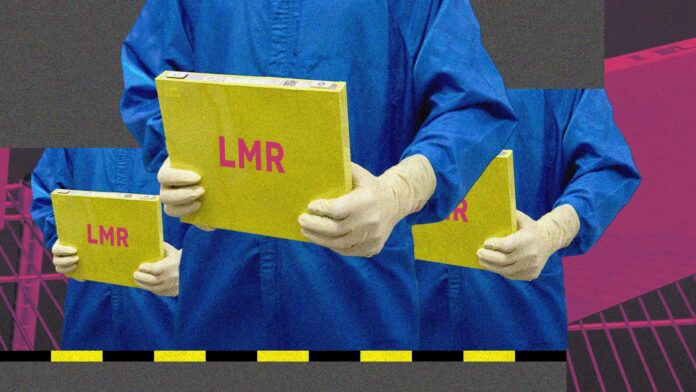
The research labs inside General Motors’ Global Technical Center aren’t what spring to mind when you think of a traditional car company.
The labs in Warren, Michigan, just north of Detroit, are top-secret facilities. They have long, empty corridors illuminated with bright white lights. Each corridor is spotless, feeling clinical and eerie. Few windows offer a glimpse at the scientists working in full safety suits.
It’s a strikingly futuristic setup for a company that has a long history of making combustion engines. But what those scientists are working on is, in many ways, even more important: the next-generation lithium manganese-rich (LMR) batteries that will power GM’s future electric vehicles.
About 30 miles from this facility, Ford is also developing its own LMR batteries at its Ion Park research hub in Romulus, southwest of Detroit. The Dearborn automaker has been working on these batteries for four years and recently reached a breakthrough, announcing the start of pilot production in Michigan. This is when automakers make small-scale versions to test and refine them before full-blown manufacturing begins.
If either American automaker can pull this off—or, ideally, both—then the United States may have a chance to outmaneuver China in the EV and battery race.
Photo by: InsideEVs
As China has run away with a massive technology lead, America’s auto giants are grappling with unpredictable regulations, tariffs and the end of emissions rules that promised to accelerate EV adoption. Even before the Trump administration threw the Biden-era EV initiatives into chaos, automakers struggled with profitability and high costs—often because of the batteries themselves and also due to China’s stranglehold on supply chains.
U.S. automakers are now looking to carve out an electric future of their own. GM and Ford say LMR can help them achieve that goal. This new chemistry should reduce the cost of EVs, making them more accessible without sacrificing range and performance.
InsideEVs interviewed engineers from both companies to understand what exactly these novel LMR batteries are and how they’re overcoming engineering challenges.
Welcome To General Motors’ Battery Kitchen
Photo by: Suvrat Kothari
Making EV batteries is, in many ways, harder than building internal combustion engines. They are chemically complex with far more variables on the molecular level. Even for R&D and small-scale testing, they require large halls full of equipment, millions of dollars in investments and deep technical skills—an area where China, Japan and Korea have huge advantages.
Inside GM’s Kettering R&D lab—named after legendary American inventor Charles Kettering—material scientists showed the machines they work on all day. Waist-high metal boxes line the rooms. Each one is a testbed for the powders and slurries that make up a battery cell. Large tubes flow from the ceiling for ventilation, air filtration and to supply specific gases or compressed air for the chemistry experiments.
One engineer showed me a machine used for “cathode material synthesis,” the scientific process of making the powder-like mix that makes up the cathode. Another explained “electrolyte development and characterization,” which involves developing the material that sits between the anode and cathode. A third engineer described the process like chefs in a restaurant.
The electrode slurry, a thick black material, turns into a “cake batter” in what she jokingly called a KitchenAid mixer. Once it reaches a “honey-like texture” in the mixer, it’s smeared onto thin sheets of metal and baked in an oven, “just like cookies.”
The wet slurry or “cake batter” that’s made of cathode active materials, a binder and solvent which goes on to form the energy storing part of the battery cell.
Photo by: General Motors
When the cells developed here meet certain criteria, they go to the Wallace Battery Innovation Center—named after Bill Wallace, who spearheaded battery development for the Chevy Volt, Bolt EV and Malibu Hybrid—within the same campus for advanced testing.
Getting Ahead Of China
For the past five years, GM engineers have been using their research labs to develop the LMR cells, starting at the small coin cell level—smaller than a penny—to building their first automotive-grade cells this year. These cells aren’t radically different from the nickel manganese cobalt (NMC) cells currently dominant in GM EVs. But they should solve the cost issues that plague many current batteries, GM claims.
China holds a commanding grip on the raw materials that power most electric vehicles sold in the U.S. and around the world. Today’s EV batteries rely heavily on nickel and cobalt—China dominates the supply chain at every step.
Roughly 85% of global battery cell production happens there, along with 65% of the world’s nickel refining and an overwhelming 75% of cobalt refining, according to a recent report from the International Energy Agency.
LFP vs NMC battery adoption
Photo by: InsideEVs
The cheaper lithium-iron phosphate (LFP) batteries are a promising alternative to nickel-based ones, but China’s lead in LFP battery production is even bigger, with nearly all EVs with LFP batteries sold in the U.S. and Europe in 2024 using packs made in China.
It’s a strategic advantage that no other country can replicate. What adds to the challenge is that both nickel and cobalt are not only in high demand but also more difficult and costly to mine and refine.
GM engineers said manganese, by contrast, is more abundant, easier to process and far less expensive, making it an increasingly attractive alternative to counter China’s chokehold on battery materials.
At GM’s Wallace Battery Cell Innovation Center, the automaker conducts advanced cell testing.
Photo by: Suvrat Kothari
Over the years, automakers have moved from using traditional NMC batteries, which use equal portions of nickel, manganese and cobalt, to high-nickel batteries, which use less cobalt and manganese, but higher nickel content. The next logical step towards cost reduction, GM says, is to reduce the nickel content and increase the portion of manganese, giving birth to what’s called the lithium manganese-rich (LMR) battery.
There’s not a lot of manganese production in North America, but it’s an opportunity to finally start producing it here to move away from China’s dominant supply chains.
The automaker loaned $85 million to manganese supplier Element 25 in 2023. At the time, GM said Element 25 will mine the manganese in a “vertically integrated” and “traceable” way from Australia. The materials will then be processed in the U.S. at what’s expected to be the first plant of its kind to produce battery-grade manganese—a huge step towards localization that has remained elusive for America.
GM estimates the LMR cells to offer 33% more energy density than current LFP cells at comparable costs. Packaging them into the prismatic form factor, which is either a square or a rectangular box, will result in 50% fewer parts on the pack level. Prismatic cells stack neatly together and require fewer structural components. GM believes these types of cells have advantages over the traditional cylindrical cells, which have lower packaging efficiency. Hundreds of pounds of weight savings are expected on the vehicle level with prismatic cells.
Above all, the LMR battery is expected to deliver over 400 miles of range on GM’s full-size SUVs and trucks.
Photo by: General Motors
“This is something we’ve made. We’ve got a partner [LG Energy Solution] that’s ready to go with us on this,” Kurt Kelty, the vice president of battery, propulsion and sustainability at GM, said during a roundtable with reporters at the GM Technical Center. “We’re going to actually see this in the marketplace.”
Kelty, who worked at Tesla for 15 years before moving to GM, acknowledged that all batteries have pros and cons. LMR cells historically suffer from capacity fade and loss of voltage over time, but GM engineers claim to have solved this issue to keep the cells stable and energy dense.
“Batteries are a bunch of trade-offs,” Kelty said. “You can optimize on fast charge, on range, on cost, but what we’ve got here is a nicely balanced cell that meets all our needs, so we can deploy it and get that great range at an affordable cost,” he added.
“It’s a game-changing battery for electric trucks, setting a new bar for performance in this important vehicle segment.”
Ford Moving ‘Full Steam Ahead’ With LMR Cells
Ford’s Ion Park is its new global battery research and development center located in Romulus, Michigan.
Photo by: Ford
Across town, Ford is comparatively tight-lipped about its LMR plans, but we have some details nonetheless. “LMR is going to be the LFP of the western hemisphere,” Charles Poon, Ford’s director of electrified propulsion engineering, told InsideEVs in an interview.
At Ford’s Ion Park R&D center in Romulus, Michigan, a team of 135 battery engineers is working like a “small skunkworks team,” as Poon described it, to bring this new chemistry to life. Just days before GM made its own LMR ambitions public, Ford announced it had achieved a similar breakthrough: It’s now running cells off a pilot production line.
While both companies are chasing LMR technology, their approaches vary. GM is targeting large trucks and full-size SUVs with prismatic LMR cells. Ford, on the other hand, is eyeing lower-cost EVs, with the flexibility to use cylindrical or pouch formats.
“We can do it with any format that exists today,” Poon said.
Ford’s LMR pouch cells rolling from a pilot production line.
Photo by: Ford
Ford currently uses two main battery types. There’s an LFP battery for the entry-level Mustang Mach-E, and an NMC pack for the F-150 Lightning, E-Transit and rest of the Mach-E lineup.The LFP battery is sourced from Chinese battery giant CATL, while the latter reportedly comes from LG Energy Solution.
The U.S.-made LMR battery is intended to slot right between them, offering more range than LFP, at a lower cost than NMC, without losing any substantial range. “LMR is the answer to ‘what next?’” Poon said.
But scaling the chemistry comes with technical hurdles. Ford had to solve three key challenges before moving toward industrialization. The first is what Poon labeled “manganese dissolution.” Manganese tends to dissolve into the electrolyte. When that happens, the battery gradually loses energy, meaning you get less range over time.
The second is what he called “gas generation.” As manganese dissolution happens, oxygen can react and produce gas inside the battery. Too much gas buildup can lead to swelling or even early battery failure. Managing this gas generation is critical to battery health and safety, he said.
Voltage was the third big challenge. LMR cells run at very high voltages, even higher than traditional NMC batteries. But high voltage can speed up wear and tear. So the challenge, Poon said, was to design a battery that could safely handle the voltage without degrading quickly.
The automaker claims to have largely solved these problems and is aiming to achieve an energy density between 550-700 watt hours per liter, or more than 200 watt hours per kilogram. That is similar to current nickel-based batteries, which generally have 200-300 Wh/kg of energy density.
The electrode coating process for Ford’s LMR EV battery cells at the Ion Park research center.
Photo by: Ford
Poon also added that LMR cells are “agnostic to charging.” In other words, LMR batteries won’t inherently charge slower or faster. Depending on which vehicle segment Ford uses them in and the voltage architecture of the pack, charging speeds could match or even exceed today’s benchmarks.
Since fast-charging physics primarily happens on the anode side, usually made of graphite or a graphite-silicon blend, the choice of cathode chemistry (whether LFP, NMC, or LMR) doesn’t directly constrain charging speed.
Speaking of the segment, Ford seems to be targeting the pocket between entry-level LFP and high-end NMC models. So LMR won’t necessarily replace LFP or NMC batteries, but enable automakers to target U.S.-specific use cases with better packaging and costs, while crucially establishing a more local supply chain that’s less centered around China.
“Cost is really one of the biggest hurdles for EV adoption,” Poon said. “Our approach is not necessarily to introduce this for premium vehicles, it’s to replace a bulk of where we currently have both high-nickel and mid-nickel chemistries,” he added.
Race To The Finish Line
Photo by: Chevrolet
GM said it intends to become the first automaker to introduce LMR cells in a production truck at the start of 2028. (The automaker didn’t disclose which truck will use this battery.)
It is already the largest producer of cells in North America. And Kelty said he believed GM is now also making cells at a lower cost than its competitors on the continent. With support from Korean battery giant LG Energy Solution, already GM’s largest battery supplier, the two companies plan to scale the production of LMR cells in about two years.
Ford is also planning to bring these cells to life by the end of the decade.
There are reasons for caution. We haven’t seen the tech on the roads yet. But Kelty made a strong case for why LMR cells are headed towards commercialization. In addition to the benefits in terms of cost and range, he said America should strive to localize the battery supply chain if it wants to produce competitive EVs. “It has nothing to do with tariffs,” he said.
Kelty experienced the complex logistics of importing cells from overseas when he was at Tesla. “We were buying cells from Japan. You put them in a container. Then they get on a boat and they sit on the water for three or four weeks. You’re paying for that material before it even arrives, which is really painful,” he said.
Tesla famously went on to mass produce batteries at its Gigafactory Nevada in 2017, integrating Panasonic’s operations within the campus in Reno, long before rivals even had any plans to localize.
The second reason to localize cells is far more consequential. “Believe it or not, sometimes battery cells have quality issues,” Kelty said. “You won’t find that out right away because you usually get a week or two weeks of inventory, and then you find out that you have to trash it all. It’s just no good.”
Strong local supply chains helped Asian manufacturers pull ahead in battery innovation. Now, with LMR breakthroughs, Ford and GM may have a real shot at closing the gap by developing U.S.-made cells that could lower costs, maintain range and performance and finally step out of China’s shadow.
If they deliver on their promises, it could unlock the next phase of growth for America’s EV industry.
Have a tip? Contact the author: suvrat.kothari@insideevs.com


